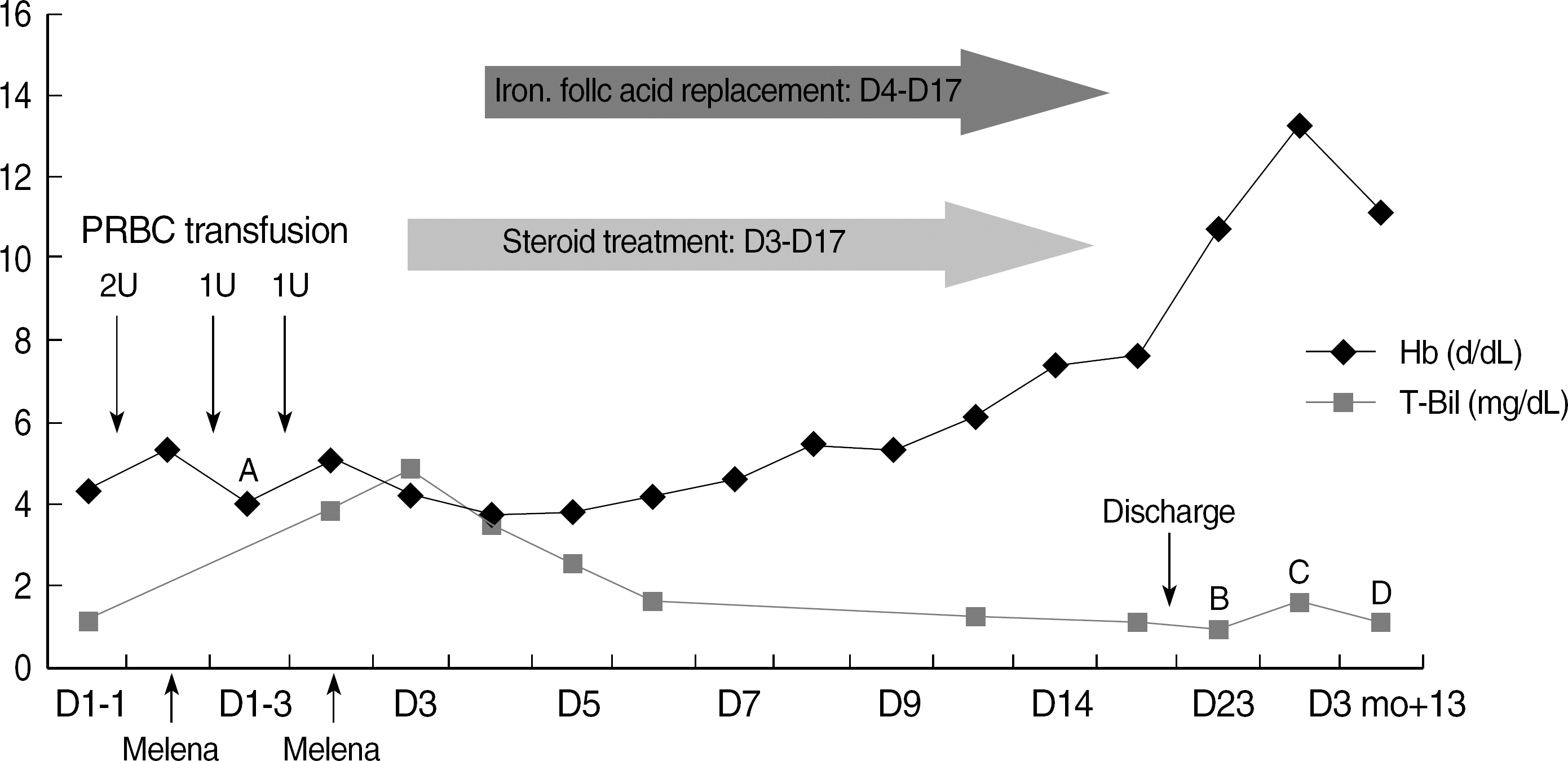Abstract
REFERENCES
Fig. 1.

Table 1.
| D1-1 | D1-2∗ | D1-3∗ | D2∗ | D3 | D4 | D6 | D11 | D14 | D16 | Reference range | |
|---|---|---|---|---|---|---|---|---|---|---|---|
| WBC (103/μL) | 12.2 | 21.9 | 6.8 | 8.9 | 9.4 | 2.6 | 3.5 | 3.7 | 3.9-9.7 | ||
| Hb (g/dL) | 4.4 | 5.4 | 4 | 5.2 | 4.2 | 3.7 | 4.2 | 6.2 | 7.4 | 7.7 | 11.7-17.1 |
| PLT (103/μL) | 128 | 45 | 30 | 38 | 54 | 62 | 82 | 89 | 134-387 | ||
| T-Bil (mg/dL) | 1.1 | 3.9 | 4.9 | 3.4 | 1.6 | 1.1 | 1.1 | 0.2-1.2 | |||
| D-Bill (mg/dL) | 0.6 | 1.5 | 1.6 | 2 | 1.4 | 0.7 | 0.0-0.4 | ||||
| Plasma Hb (mg/dL) | 41.1 | 31.8 | 13.5 | 0.0-10.0 | |||||||
| urine Hb | + | + | + | ||||||||
| LDH (U/L) | 511 | 628 | 449 | 173 | 100-200 | ||||||
| Haptoglobin (mg/dL) | <10 | <10 | <10 | 30-200 | |||||||
| BUN (mg/dL) | 35 | 28.1 | 25.5 | 21 | 11.5 | 22.9 | 70.3 | 16.4 | 8-25 | ||
| Cr (mg/dL) | 1.2 | 0.9 | 0.7 | 0.7 | 0.8 | 0.9 | 1.0 | 1.0 | 0.5-1.4 | ||
| PT (sec) | 20.1 | 15.4 | 19.2 | 17.6 | 17.4 | 10.2-13.8 | |||||
| aPTT (sec) | 31 | 35 | 34 | 35 | 31 | 25-37 | |||||
| FDP (μg/mL) | >20 | 0-4 | |||||||||
| D-dimer (μg/mL) | 3.09 | 0.00-0.35 | |||||||||
| DAT | IgG(+), C3d(-) | ||||||||||
| Ab titration | 1:128 |
∗ The patient received two units of packed red blood cells (PRBCs) before sampling on D1-2, one unit of PRBCs before D1-3, and one unit of PRBCs before D2.
Abbreviations: D1-1, the first laboratory test on admission day 1; D1-2, the second laboratory test on admission day 1; D1-3, the third laboratory test on admission day 1; D16, admission day 16; WBC, white blood cell; Hb, hemoglobin; PLT, platelet; T-Bil, total bilirubin; D-Bil, direct bilirubin; LDH, lactate dehydrogenase; BUN, blood urea nitrogen; Cr, creatinine; PT, prothrombin time; aPTT, activated partial thromboplastin time; FDP, fibrinogen degradation product; DAT, direct antiglobulin test; Ab, antibody.




 PDF
PDF ePub
ePub Citation
Citation Print
Print


 XML Download
XML Download